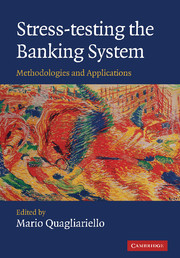Book contents
- Frontmatter
- Contents
- List of figures
- List of tables
- List of boxes
- List of contributors
- Foreword
- Acknowledgements
- Introduction
- Part I Fundamentals
- Part II Applications
- 8 Stress-testing credit risk: the Italian experience
- 9 Stress-testing US banks using economic-value-of-equity (EVE) models
- 10 A framework for integrating different risks: the interaction between credit and interest rate risk
- 11 Stress-testing linkages between banks in the Netherlands
- 12 An integrated approach to stress-testing: the Austrian Systemic Risk Monitor (SRM)
- 13 From macro to micro: the French experience on credit risk stress-testing
- 14 Stress-testing in the EU new member states
- 15 Cross-border macro stress-testing: progress and future challenges for the EU
- 16 Stress-testing at the IMF
- Conclusions
- Index
- References
9 - Stress-testing US banks using economic-value-of-equity (EVE) models
from Part II - Applications
Published online by Cambridge University Press: 18 December 2009
- Frontmatter
- Contents
- List of figures
- List of tables
- List of boxes
- List of contributors
- Foreword
- Acknowledgements
- Introduction
- Part I Fundamentals
- Part II Applications
- 8 Stress-testing credit risk: the Italian experience
- 9 Stress-testing US banks using economic-value-of-equity (EVE) models
- 10 A framework for integrating different risks: the interaction between credit and interest rate risk
- 11 Stress-testing linkages between banks in the Netherlands
- 12 An integrated approach to stress-testing: the Austrian Systemic Risk Monitor (SRM)
- 13 From macro to micro: the French experience on credit risk stress-testing
- 14 Stress-testing in the EU new member states
- 15 Cross-border macro stress-testing: progress and future challenges for the EU
- 16 Stress-testing at the IMF
- Conclusions
- Index
- References
Summary
Introduction
Since the early 1980s, American banks have been using ‘economic-value-of-equity’ (EVE) models to help measure and manage their banking-book interest rate risk (IRR). These models estimate the fair value of the institutions' financial instruments as a function of the current interest rate environment (the ‘base-case’ EVE). The modeller then specifies alternative stress scenarios, and estimates the resulting change from base-case EVE. This change is usually expressed as a percentage of the base-case estimate.
Banks develop and use internal EVE models to quantify and control their interest rate risk. For executive management and bank supervisors, a common benchmark interest rate scenario is an instantaneous plus/minus 200-basis-point shock to the current yield curve. That benchmark is typically used to set a risk limit, e.g., the banking-book IRR manager will tolerate an exposure of no more than 20 per cent of base-case EVE for the 200-basis-point shock.
Banking supervisors also have their own EVE models. The OCC uses these to estimate banks' exposure under a common set of assumptions, allowing peer comparisons. This provides a basis for supervisory actions against banks that have excessive exposures relative to industry norms.
For the middle management responsible for interest rate risk, EVE models are used for day-to-day management. For that purpose, the shocks are estimated in a comprehensive range, e.g., 10-basis-point increments up to the 100-basis-point shock, or whatever is deemed the maximum shock likely before the manager can react.
- Type
- Chapter
- Information
- Stress-testing the Banking SystemMethodologies and Applications, pp. 149 - 164Publisher: Cambridge University PressPrint publication year: 2009
References
- 1
- Cited by



